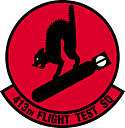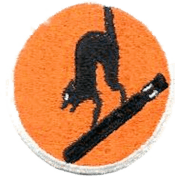413th Flight Test Squadron
| 413th Flight Test Squadron | |
|---|---|
|
A CV-22 Osprey from the 413th FLTS hovers over Hurlburt Field, Florida | |
| Active | 15 July 1942 - Present |
| Country |
|
| Branch |
|
| Type | Squadron |
| Role | Flight Testing |
| Part of |
|
| Garrison/HQ | Duke Field, Eglin Air Force Base, Florida |
| Engagements |
World War II Cold War |
| Decorations |
|
| Insignia | |
| 413th Flight Test Squadron emblem |
 |
| Aircraft flown | |
| Multirole helicopter | CV-22 Osprey |
| Utility helicopter | UH-1 Iroquois |
| Transport | MC-130/HC-130 Hercules |
The 413th Flight Test Squadron (413 FLTS) is part of the 96th Test Wing and is based at Duke Field, Eglin Air Force Base, Florida. It performs flight testing on C-130 Hercules, CV-22 Osprey, MH-53 Pave Low, UH-1 Iroquois, and HH-60 Pave Hawk aircraft.
Overview
The squadron planned, provided for, and conducted tests of electronic warfare and avionics systems and equipment, on aircraft assigned to the Air Force Flight Test Center between 1977 and 2004. It has planned, executed and managed Development and Qualification Test and Evaluation of fixed-wing aircraft assigned to Air Force Special Operations Command and of all Air Force helicopters since 2005.
History
World War II
Initially established as a B-17 Flying Fortress reconnaissance squadron in early 1942, re-designated as a Heavy Bombardment squadron and activated in July. Trained under II Bomber Command in the northwestern United States, then moved to Texas for better flying weather in early 1943. Deployed to England and assigned to VIII Bomber Command.[1]

Flew first combat mission over Occupied Europe on 14 May 1943, Participated in the famous Regensburg shuttle mission to North Africa. Took part in the Big Week Schweinfurt mission of 14 October 1943. In addition, the squadron attacked shipyards, harbours, railway yards, aerodromes, oil refineries, aircraft factories, and other industrial targets in Germany, France, the Netherlands, Belgium, Norway, Poland, Hungary, and Czechoslovakia.[2]
Participated in very long-range mission through heavy clouds and intense anti-aircraft fire to raid important aircraft component factories in Poland on 9 April 1944. Other significant targets included airfields at Bordeaux and Augsburg; marshalling yards at Kiel, Hamm, Brunswick, and Gdynia; aircraft factories at Chemnitz, Hanover, and Diósgyőr; oil refineries at Merseburg and Brüx, and chemical works in Wiesbaden, Ludwigshafen, and Neunkirchen[2]
In addition to strategic operations, missions included bombing coastal defences, railway bridges, gun emplacements, and field batteries in the battle area prior to and during the invasion of Normandy in June 1944; attacking enemy positions in support of the breakthrough at Saint-Lô in July 1944; aiding the campaign in France in August by striking roads and road junctions, and by dropping supplies to the Maquis; and attacking, during the early months of 1945, the communications supplying German armies on the western front.[2]
After V-E Day, flew food missions to the Netherlands and hauled redeployed personnel to French Morocco, Ireland, France, and Germany. In November 1945 its aircraft were flown back to the United States, and was inactivated on 19 December 1945.[1][2]
Cold War
Was reactivated as an B-29 Superfortress Air Force Reserve squadron in 1947 at Keesler Field (later AFB), Mississippi. Unit may or may not have been equipped with aircraft, possibly was an administrative unit with no personnel assigned. Was inactivated on 27 June 1949 due to budget reductions.[1][3]
The squadron was activated in November 1958 as a result of Strategic Air Command phasing out the B-47 Stratojet, and additional squadrons were activated as part of the consolation of Stratojet wings, and the replacement of the B-47 by B-52 Stratofortresses. In March 1961, President John F. Kennedy directed that the phaseout of the B-47 be accelerated. and the squadron was inactivated on 1 January 1962 as part of the drawdown of the USAF B-47 force, with the aircraft were sent to AMARC storage at Davis-Monthan.[1][3]
Flight testing
The 6513th Flight Test Squadron (known as the "Red Hats") was activated at Edwards AFB, California on 1 December 1977 as part of the USAF Flight Test Center. The squadron was assigned to Edwards, although it operated from Tonopah Test Range Airport, Nevada to perform technical evaluations of acquired Soviet Aircraft. A similar organization, the 4477th Test and Evaluation Squadron ("Red Eagles") performed clandestine flight testing of the aircraft. In October 1992 at the end of the Cold War, the squadrons were inactivated with the 6513th being consolidated with the 413th Test Squadron which was reactivated. The Red Hats, however, possibly continued to conduct FME projects, apparently as an unnumbered squadron at an undisclosed location in Nevada.[4][5]
The 413th performed flight testing of electronic warfare (ECM) assets at Edwards. Inactivated in March 2004 as part of a consolidation and realignment of EW assets, remaining personnel and assets were transferred to Electronic Warfare Directorate North Base (412TW/EWAH).[4]
Reactivated at Hurlburt Field, Eglin AFB, Florida in February 2005, providing flight testing of special operations aircraft and helicopters under the 46th Test Wing. Moved to Duke Field at Eglin in 2012 due to budget reductions.[6]
Lineage


- Constituted as 23d Reconnaissance Squadron (Heavy) on 28 January 1942
- Re-designated 413th Bombardment Squadron (Heavy) on 22 April 1942
- Activated on 15 July 1942
- Re-designated 413th Bombardment Squadron, Heavy, on 20 August 1943
- Inactivated on 19 December 1945
- Re-designated 413th Bombardment Squadron, Very Heavy, on 3 Jul 1947
- Activated in the Reserve on 17 July 1947
- Inactivated on 27 June 1949
- Re-designated 413th Bombardment Squadron, Medium, on 20 August 1958
- Activated on 1 November 1958
- Discontinued, and inactivated, on 1 January 1962
- Consolidated (1 October 1992) with the 6513th Test Squadron, which was designated, and activated, on 1 December 1977
- Re-designated: 413th Test Squadron on 2 October 1992
- Re-designated: 413th Flight Test Squadron on 1 March 1994
- Inactivated on 6 May 2004
- Activated on 25 February 2005.
Assignments
- 96th Bombardment Group, 15 July 1942 – 19 December 1945; 17 July 1947 – 27 June 1949
- 96th Bombardment Wing, 1 November 1958 – 1 January 1962
- Air Force Flight Test Center, 1 December 1977
- 6510th (later, 412th) Test Wing, 1 March 1978
- 412th Operations Group, 1 October 1993 – 6 May 2004
- 46th Operations Group, 25 February 2005 – 18 July 2012
- 96th Operations Group, 18 July 2012 – Present
Stations
|
|
Aircraft
- Boeing B-17 Flying Fortress, 1942-1945
- Boeing B-47 Stratojet, 1958-1961
- Lockheed C-130 Hercules, 2005–Present
- MH-53 Pave Low, 2005-2008
- Bell UH-1 Iroquois, 2005–Present
- HH-60 Pave Hawk, 2005–Present
- CV-22 Osprey, 2007–Present
- Lockheed HC-130J Combat King II, 2010–Present
- MC-130J Commando II, 2011–Present
- Lockheed AC-130J Ghostrider, 2014–Present[1]
See also
References
![]() This article incorporates public domain material from the Air Force Historical Research Agency website http://www.afhra.af.mil/.
This article incorporates public domain material from the Air Force Historical Research Agency website http://www.afhra.af.mil/.
- 1 2 3 4 5 6 7 8 USAF 413th Flight Test Squadron History
- 1 2 3 4 Freeman, Roger A. (1978) Airfields of the Eighth: Then and Now. After the Battle ISBN 0-900913-09-6
- 1 2 Ravenstein, Charles A. (1984). Air Force Combat Wings, Lineage & Honors Histories 1947-1977. Washington, DC: Office of Air Force History. ISBN 0-912799-12-9.
- 1 2 Red Hats 6513th Flight Test Squadron
- ↑ Davies, Steve (2008), Red Eagles, Oxford, United Kingdom: Osprey, pp. 352, ISBN 978-1-84603-378-0
- ↑ Rogers, Brian. (2005). United States Air Force Unit Designations Since 1978. Hinkley, UK: Midland Publications. ISBN 1-85780-197-0.
- Maurer, Maurer, ed. (1983) [1961]. Air Force Combat Units of World War II (PDF) (reprint ed.). Washington, DC: Office of Air Force History. ISBN 0-912799-02-1. LCCN 61060979.
- Maurer, Maurer, ed. (1982) [1969]. Combat Squadrons of the Air Force, World War II (PDF) (reprint ed.). Washington, DC: Office of Air Force History. ISBN 0-405-12194-6. LCCN 70605402. OCLC 72556.


